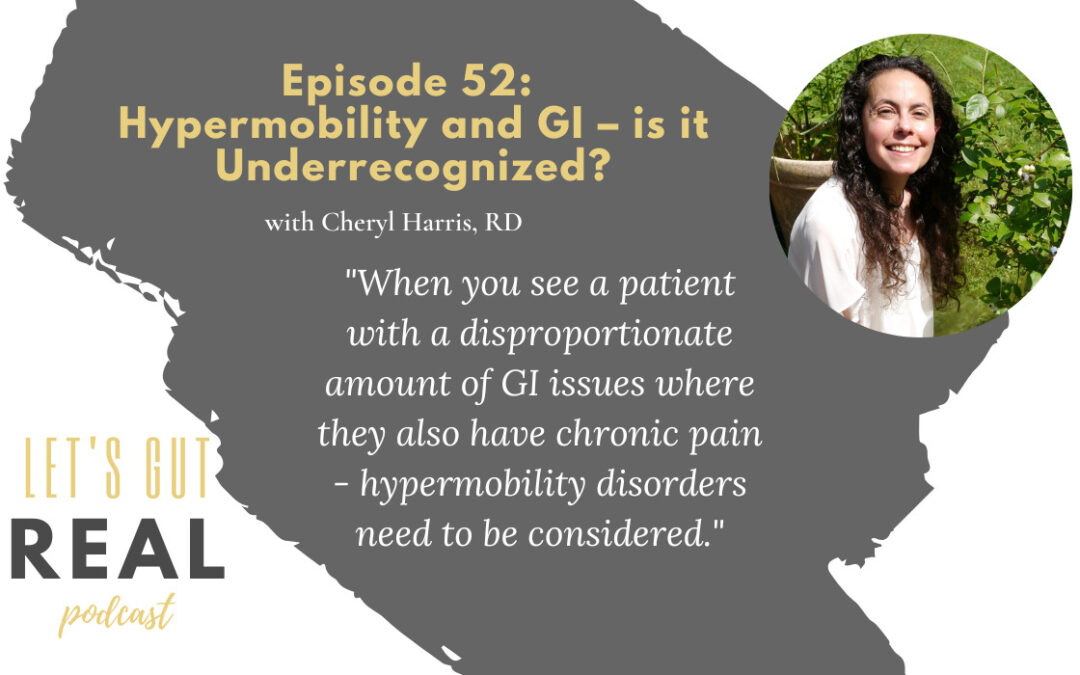Hypermobility overlaps with GI symptoms – however it is frequently under-recognized and under-diagnosed, leading to poor outcomes for patients.
Nutrition Pearls for Hypermobility and Gut Health:
- Hypermobility Ehlers-Danlos Syndrome (hEDS) is one of the various types of Hypermobility Spectrum Disorders (HSD).
- Being very flexible doesn’t mean you have hEDS, but patient with a history of hyper-flexibility may develop hEDS later in life. Either as a result of aging or as they develop different issues or sicknesses.
- The diagnostic criteria for hEDS is both having hyper-flexibility in conjunction with frequent dislocations, frequent pain, and also other kinds of symptoms.
- hEDS is diagnosed by a doctor or rheumatologists using the Beighton criteria.
- hEDS can impact all digestive issues – especially functional gut disorders like IBS.
- Hypermobility is much more prevalent in females than in males.
- Although there is no consensus of what diets are most helpful, however expert opinion is that a low-FODMAP diet can help with hEDS symptoms to help ease gas, bloating, diarrhea, and also constipation.
- Common symptoms associated with hEDS include nausea, gastroparesis, constipation, functional dyspepsia, dysmotility, and SIBO.
- HSD and hEDS overlap with a lot with other GI impacting conditions including postural orthostatic tachycardia syndrome (POTS) and mast cell activation syndrome (MCAS).
- POTS is managed with nutrition and lifestyle and in particular a whole lot of fluid and a whole lot of salt. This needs to be tailored to the patient, particularly if they have cardiovascular or kidney issues.
- Because POTS is often post-viral, rates of POTS are increasing due to COVID-19.
- Eating disorders are very prevalent in both patients with POTS and patients with EDS and needs to be taken into consideration as well.
- Symptom management for MCAS includes avoiding histamines as well as medication management.
Hypermobility spectrum disorders are estimated to be among 3% of the general population. GI practitioners should be aware of hypermobility and the symptoms, because whether we recognize it or not, we’re seeing these patients all the time. This week I interview Cheryl Harris, RD on the overlap between hypermobility and GI disorders to help guide practitioners towards recognizing it in their digestive health patients.
Cheryl Harris, MPH RD has been a dietitian for 20 years and has specializing in digestive disorders for 15 years. She was recognized as one of the top nutritionists in the DC metro area by the Washingtonian and was selected as the “Emerging Dietetics Leader of the Year” for Virginia. She has presented and written widely on digestive concerns and was honored to teach part of the AND Certificate of Training in Gluten-related disorders. She is honored to serve on the International Consortium for Ehlers-Danlos and Hypermobility Spectrum Disorders Diet and Nutrition Working Group.
Cheryl Harris and I talk about:
- How Cheryl started working in GI
- What EDS is
- How digestion is impacted by EDS
- How EDS is currently managed
- Some important nutritional considerations in the management of EDS
- Conditions that overlap with EDS including POTS and MCAS
- What POTS is
- Why these conditions overlap and how the presentation of multiple lesser-recognized conditions complicate management for patients
- How nutrition plays a role in POTS
- How dietitians & other health care providers can better screen for, recognize and refer to ensure patients get a more timely diagnosis. What some of the red-flags are and who should they refer to
Connect with Cheryl on her website at harriswholehealth.com on her email at cheryl(at)harriswholehealth(dot)com or on Twitter or on her Facebook here as well!



Recent Comments